Jelly Bean Sensory Bin and Color Sorting
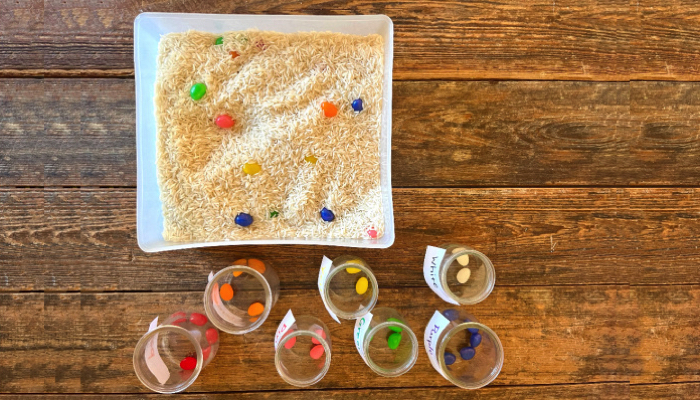
This post may contain affiliate links; please see our terms of use for details.
Jelly beans are both fun to eat and fun to play with. With their bright colors and delicious smells, they make a great addition to a sensory bin and are easy to find in grocery stores.
With Easter candy still in our pantry, my kids have been begging for treats daily. The brightly colored treats are a fun way to celebrate the warmer weather and blooming flowers. We happened to have a bag of beautiful, round jelly beans we used for our Easter Egg Matching Game and other homeschool activities.
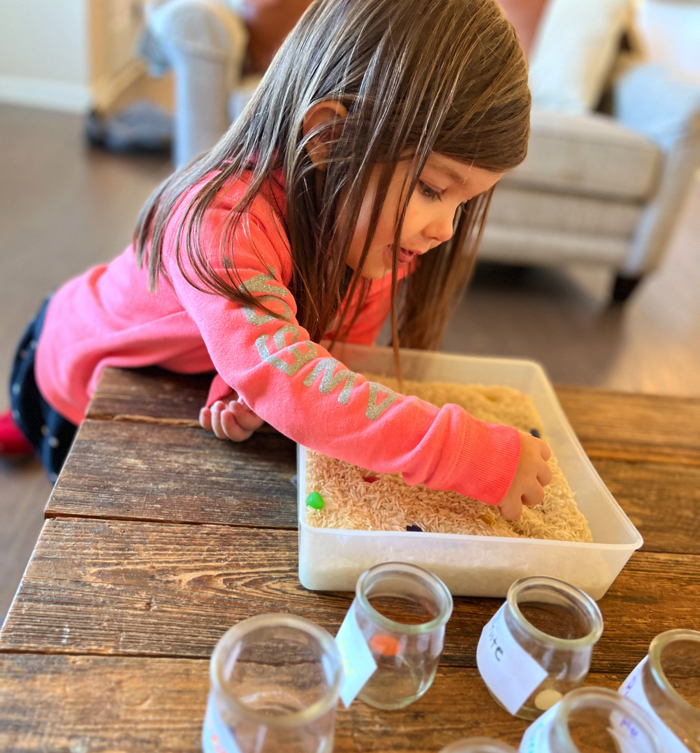
My three-year-old loves sensory bins, so I quickly created this rice-based sensory bin for her to explore. Not only does this keep her busy while I cook dinner, but it also helps solidify color names and sorting. It’s a win for both of us.
You’ll love how easy this sensory bin is to create. You’ll only need a few supplies and a bag of jelly beans. This Jelly Bean Sensory Bin and Color Sorting activity is sure to delight!
Jelly Bean Sensory Bin and Color Sorting: What You’ll Need
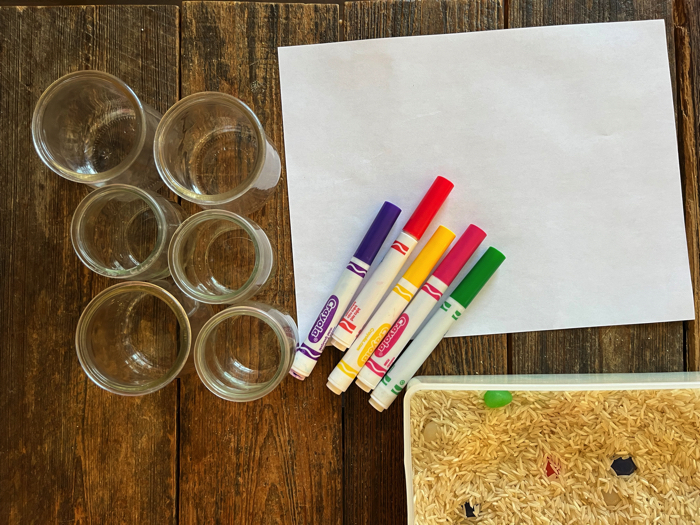
As a busy mom of five, I don’t have much free time for creating activities. Many of our homeschool lessons and crafts are simple and quick to assemble, and this color-sorting sensory bin is no exception.
Here’s all you need to put together this activity:
Materials:
- White rice
- Jelly beans
- Small bowls or glasses
- Strips of paper
- Tape
How to Make the Jelly Bean Sensory Bin
To assemble the bin and sorting cups, follow these steps:
Step 1: Measure Out Rice
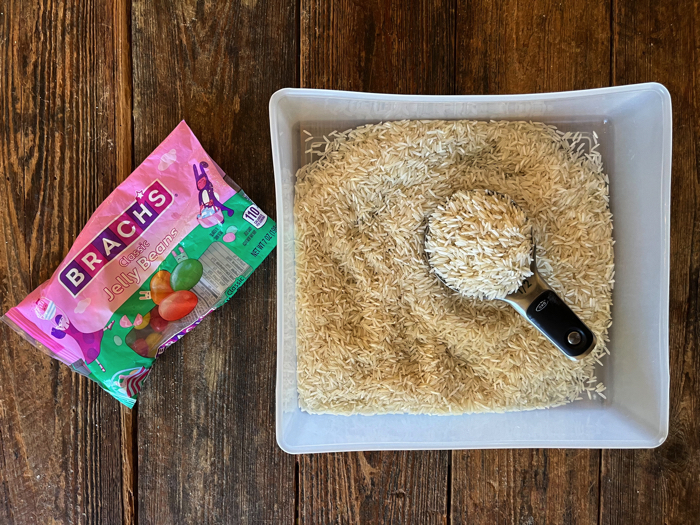
We used about five cups of white rice to fill the container. Measure out enough rice to fill the bin and cover the jelly beans. You want the rice to be deep enough to make it somewhat challenging for your child to find the beans.
Step 2: Add Jelly Beans
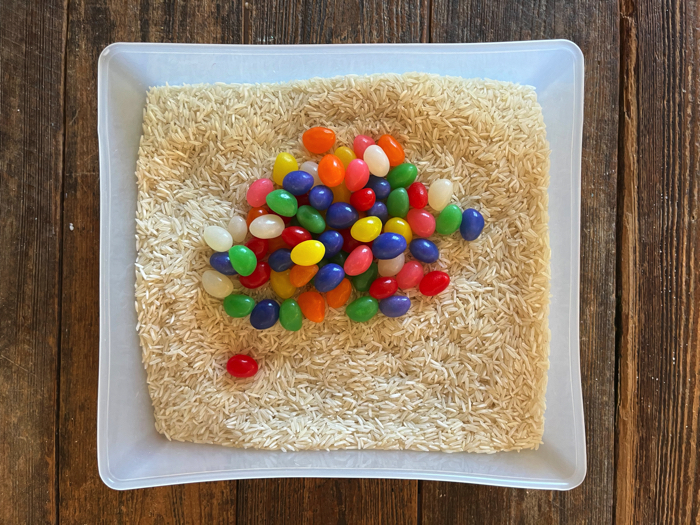
Add a bag of jelly beans to the rice and mix them in. We used fat jelly beans to make it easier for tiny hands to pick up, but the smaller varieties of jelly beans would work as well.
Step 3: Create Sorting Cups
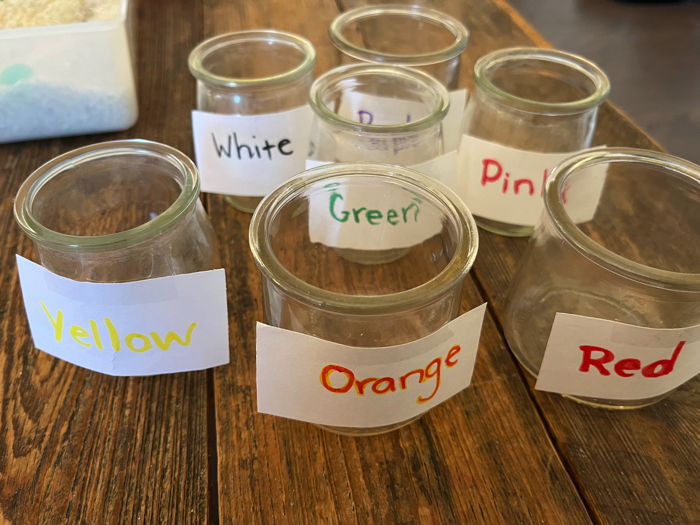
Take small bowls or cups and label them with color names. I used strips of white paper and wrote the color names on them with markers. If your child is too young to read, write the words using that color marker so they can easily recognize it.
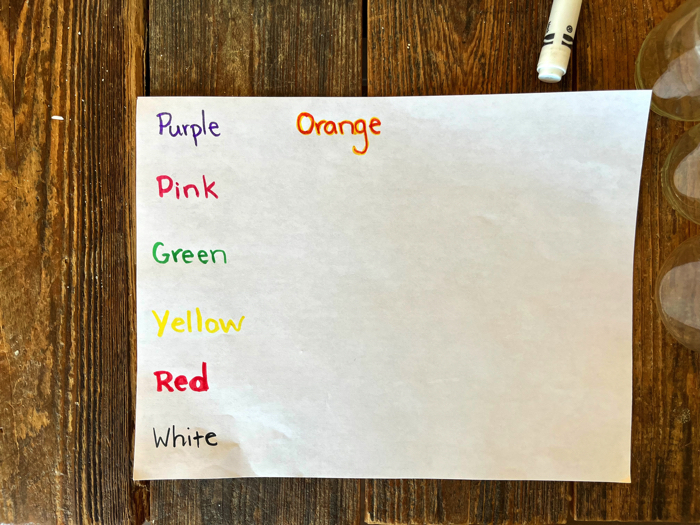
I taped the strips of paper to the cups. Be sure each color jelly bean has a cup to be sorted in.
Time to Play
After setting up the sensory bin, it’s time for your child to play and explore. Here are a few ways we used this set:
Jelly Bean Hunt
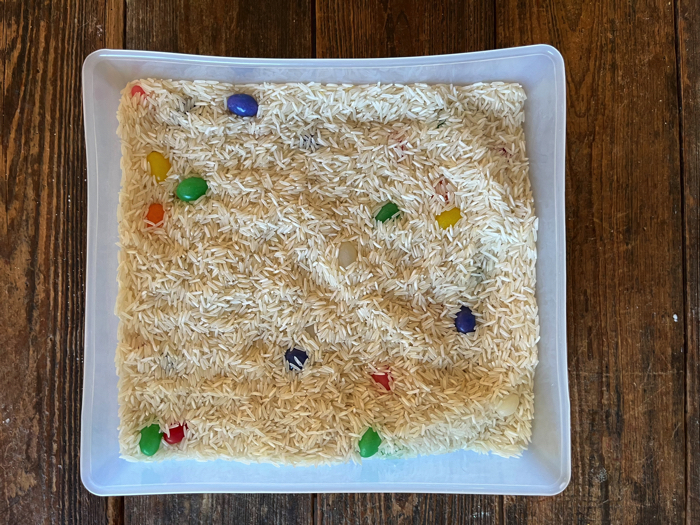
Mix the jelly beans in the rice and tell your child they’re going on a jelly bean “egg hunt.” As they collect the beans, help them sort them in the correct containers. Continue until all the jelly beans have been found.
Jelly Bean Count
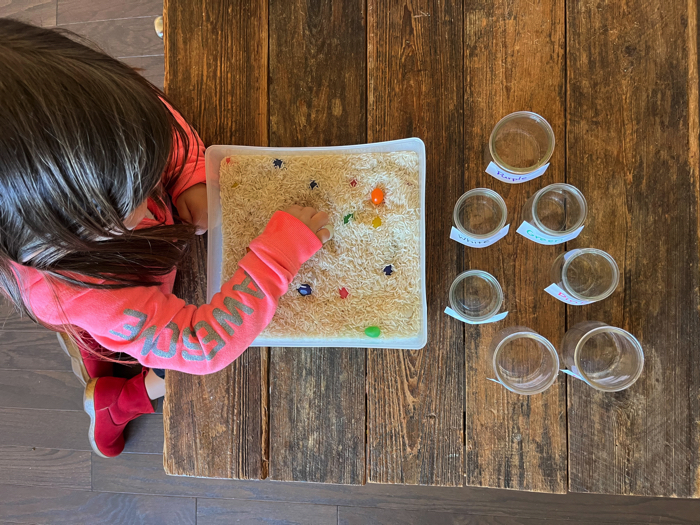
After collecting the jelly beans, line up each color. Have your child count the beans of each color. Talk about which color has the most and least amount of jelly beans.
Jelly Bean Ice Cream Shop
My kids love playing games like “restaurant” or “coffee shop.” Turn this sensory bin into a pretend play ice cream shop by including spoons and bowls. Have your child scoop up rice and top it with jelly beans as the toppings.
Jelly Bean Road Patterns
Using the jelly beans, have your child create a road for toy cars to drive on. Use the jelly beans to form the outside lines of the road. As your child makes the roadway, show them how to alternate colors in patterns.
Little ones will love driving cars through the rice following the jelly bean lanes. They can move and recreate the road lines as much as they’d like, making new patterns each time.
Tactile Letter Formation
When creating tactile letters, like our tactile alphabet cookies or braille alphabet tubs, kids are more likely to retain the information. A tactile letter lesson gives a child both visual and tactile input on what the letter looks like.
Using alphabet flashcards or a letter drawn on paper, show your child the letter you want them to create. Have your child line up the jelly beans on the rice in the shape of that letter. You can draw the letter in the rice with your finger first to give them an outline to follow.
Jelly Bean Relay Race
For a gross motor activity outdoors, place the sensory bin on one side of your backyard. On the other side, place an empty bowl for collecting the jelly beans.
Have your child race to quickly find jelly beans in the rice. They’ll scoop up the beans, a few at a time, with a spoon and race to the bowl to dump them. Have them continue until all the beans have been found and placed in the empty bowl.
What Can I Use Instead of Rice?
We love rice for sensory tables, sensory bags, and sensory bins. However, there are plenty of other fillers that will provide tactile input. We’ve also used water beads, pasta, and play sand.
A messier but equally fun option is the fake snow from our snowy animals sensory bin.
What Can I Use Instead of Jelly Beans?
- Sweep Those Bunnies!: Specially designed for toddlers, this fun set helps little ones build gross motor skills as they sweep, snag, and sort friendly dust bunnies during get-up-and-move toddler activities!
- 6 Ways to Move: Spin this educational toy set’s gross motor activity spinner before each round to send kids hopping, dancing, and tiptoeing after the bunnies—there are 6 fun movements in all!
- Reusable Storage: Save this set’s reusable plastic storage container for an easy way to clean up once the gross motor fun is done for the day!
- Ages and Stages: Specially designed with little ones in mind, this educational toy for ages 3+ build essential early gross motor skills—it also works as a color teaching toy!
Jelly beans aren’t the only option for this color-sorting activity. If you don’t mind using candy, I like M&M’s, chocolate eggs, or Skittles for teaching colors. I often let my kids snack on a few pieces after the activity as a treat.
If you prefer to use a non-candy sorting item, try painted rocks, pom-poms, plastic easter eggs, or these cute counting dust bunnies.
What Other Ways Can I Teach Color Recognition?
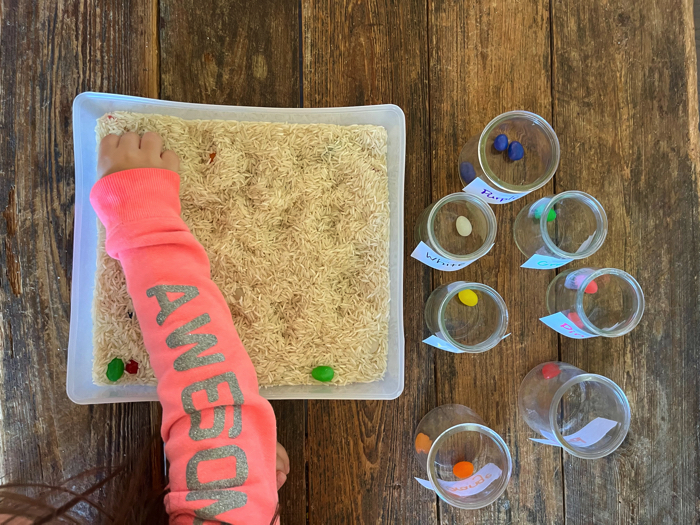
Color recognition is an important skill for preschool and kindergarten-aged children to master. Parents can provide extra practice identifying colors through simple activities.
To help your child learn color names quickly, you’ll want to provide daily practice. Try naming the colors of your child’s foods at lunch. As you drive in the car, point out cars, signs, and other objects in a certain color.
There are also plenty of other color-sorting activities that make color recognition a game. My kids enjoyed our mushroom color sorting activity as well as our rainbow playdough cutting station.
If your child loves music, play Learn Your Colors by Jack Hartmann. This song will have you jamming along as your child yells out color names.
What Else Can I Add to the Jelly Bean Sensory Bin?
Jelly beans are just one item you can add to this sensory bin. Keep the spring theme going by adding in any of these other items:
- Dyed rice (like our Unicorn Sensory Rice)
- Easter eggs
- Peep Marshmallows
- Small rubber ducks
What Are the Benefits of Playing With Sensory Rice?
I love using sensory rice to strengthen my child’s coordination and muscle development. Besides adding an element of fun to playtime, the sensory bin can also help your child develop in other ways.
Builds Fine Motor Skills
When I create fine motor activities for preschoolers, I try to make them simple but effective. Playing with rice is an excellent example of an inexpensive and fun fine motor game. Picking up the jelly beans and scooping the rice are both fine motor activities.
To challenge your child, have them place the jelly beans in a container with a small opening, such as a water bottle. You can also have them pick up the jellybeans using a pair of tongs.
Provides Sensory Exploration
As your child explores the rice, their brain will be busy gathering all of the sensory input that comes through their five senses. The grains of rice provide tactile input through their fingertips. All of the input comes together to help your child understand the world around them.
Sensory play sparks children’s creative thinking, questioning, reasoning, and problem-solving skills. Encourage your child to find new ways to play with the sensory bin.
Calms Emotions
For parents of children who experience sensory meltdowns, sensory bins might be a helpful tool. Much like playing with playdough or swinging in sensory swings, playing with rice has a calming effect. Offering a sensory bin to an overstimulated child might provide an alternative focal point.
What Other Ways Can I Enrich This Activity?
- Hardcover Book
- Carle, Eric (Author)
- English (Publication Language)
- 32 Pages – 02/07/2023 (Publication Date) – HarperCollins (Publisher)
We love springtime activities! Try any of these activities to continue the learning and fun:
- Read the book Spring Sings for the Grouchy Ladybug by Eric Carle
- Use water beads to create another sensory bin
- Make this Silly Spinning Easter Egg Craft
- Make your own egg hunt sensory game
- Play with this color shapes egg set that works on shape recognition too
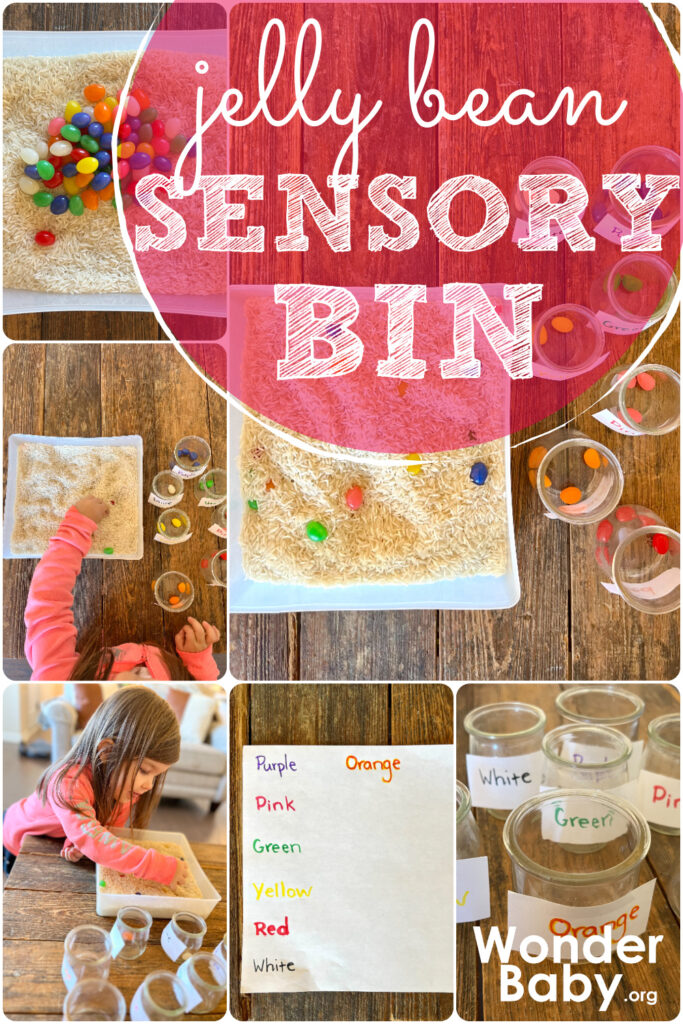
Related Posts

Braille and Literacy, Toys, Visual Impairment
24 Braille Toys for Kids Who are Blind
Everything from alphabet blocks to raised line coloring pages and activity books to puzzles to card and board games... and so much more! And it's all in braille ready for...
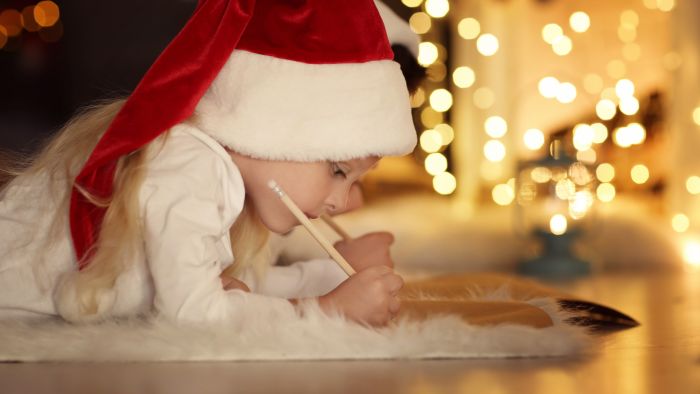
Holiday Crafts and Ideas
Should Parents Lie to Their Kids About Santa Claus?
Should parents lie about Santa? Find out how to balance trust, magic, and holiday traditions right here!
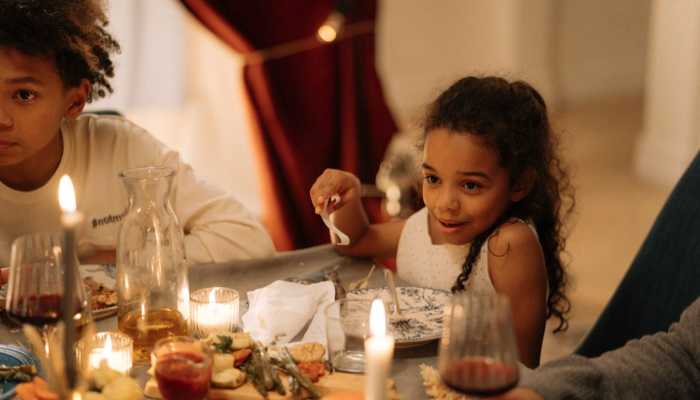
Holiday Crafts and Ideas, Special Needs
5 Tips for a Peaceful Thanksgiving with Your Child with Disabilities
Thanksgiving can be a joyful yet overwhelming holiday, especially for families with children who have sensory, motor, or dietary needs.

